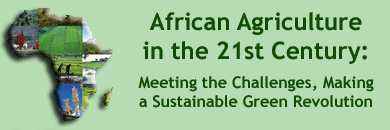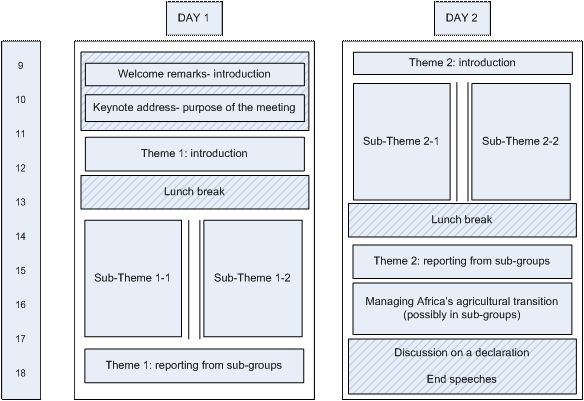Links to Sustainable Development Topics by Alphabetical Order
2010/2011 CSD Topics
Africa
Secondary Links
High-Level Meeting

Windhoek, Namibia, 9-10 Feb 2009
Agenda Overview
- Theme 1. how to operationalize a green revolution in Africa?
- Theme 2. integrating African agriculture into global markets
- Theme 3. managing Africa’s agricultural transition
Theme 1: how to operationalize a green revolution in Africa?
The overall objective of the discussion on this theme would be to contrast the two polar approaches to improving African agriculture:
- importing the “northern” model, based on intensive use of capital, inputs and fertilizers; and
- developing agriculture in more sustainable ways, through improving land management and agricultural practices.
The session aims to bring participants to:
- a nuanced view of the two systems, based on facts;
- an idea of their geographic applicability (intensive northern-style agriculture is not readily applicable to a large part of Africa that is arid or semi-arid; nor is the Asian green revolution model, based on more homogeneous agro-climatic conditions
- the social implications of the various production systems.
Sub-Theme 1.1: Incorporating sustainable land management and agricultural practices into African agriculture
Issues examined during this session will cover in particular:
- Impact of sustainable soil and land management and agricultural practices on agricultural productivity (yields, crop failure, etc)– including impact of crop biodiversity on yields
- Advances in land regeneration and fighting desertification in arid and semi-arid environments: sustainable land management practices, including agroforestry: the way forward
- Changing paradigms for staple crops: the System of Rice Intensification (SRI).
Sub-Theme 1.2: Increasing agricultural productivity in Africa
Issues examined during this session will cover in particular:
- Potential for large-scale, western-style agriculture in Africa: where can it be done, documenting the environmental and social trade-offs
- What policies are needed to increase not only the level but also the effectiveness of investment in the agricultural sector (e.g., absorptive capacity, sectoral infrastructure)
- What R&D models to boost the development of varieties adapted to African agro-climatic conditions, including for future adaptation to climate change?
- How to best support farmers’ efforts to adapt to climate change? (extension services, forestry services, meteorological information systems, drought/flood early warming systems for agriculture: what works in what context?)
Theme 2: integrating African agriculture into global markets
The overall objective of the discussion under theme 2 is to illustrate the role for governments and various institutions in supporting and promoting the transition from a subsistence-oriented agriculture, which represents the majority of African agriculture, to a market-based agriculture and eventually to export-based agriculture focused on value addition. The session aims to bring participants to better appreciate policy options in term of support to agricultural supply chains, both to position the agricultural sector strategically and to support farmers in their transition.
Sub-Theme 2.1: Moving African agriculture up the value chain
Issues examined during this session will cover in particular:
- Infrastructure and capacity building needs to meet requirements in terms of standards, certification, and sanitary and phyto-sanitary (SPS) requirements
- Institutional infrastructure to support high-value agricultural exports: What models could work in Africa? (R&D, business associations, extension services, marketing support, etc.)
- How to achieve sustainable management of resources in export-oriented agriculture?
- Promoting greater processing of agricultural and fisheries products in Africa including marketing and branding issues for high-value added agricultural products; applicability of fair trade and other models
Sub-Theme 2.2: Integration of small farmers into global supply chains
Issues examined during this session will cover in particular:
- Organizing the supply chains: lessons learnt from recent positive and negative experiences with the reforms of the cotton sector, the coffee sector, and other sectors
- Innovative models to manage the transition from self-dependence to larger-scale and market-based agriculture (including providing association of small farmers with capacity to produce consistent quality)
- Making agricultural finance a reality: recent experiences (trade finance within the supply chain; warehouse receipt lending; long-term contracts; commodity exchanges; index-based insurance for agriculture; others)
- Managing the biofuel boom and small holders’ access to land: innovative models
Session 3: managing Africa's agricultural transition
Based on the discussion of the two themes above, this session will attempt to develop a vision of the steps needed to manage the transition of Africa’s agriculture in the coming years. In order to keep it focused on issues central to the next session of the Commission on Sustainable Development, the discussion will focus on 4 or 5 themes extracted from the last section of the UN Secretary-General’s report on Africa prepared for CSD-17.
This session will examine the policies and actions that would be needed to address the economic, social and environmental issues that will arise in the next one or two decades as Africa’s agriculture become more productive and integrated into markets. The session will be structured to facilitate the discussion on the necessary policies.
- Managing the food security versus biofuels dilemma: securing land tenure for small holders; avoiding transforming self-sufficient farmers into wage labor; innovative ways to involve farmer communities in small-scale biofuel projects; regulatory social safeguards for biofuel production.
- Medium- and long-term needs in education, health and social infrastructure in rural areas: how to set priorities? what development models, what incentives and safety nets?

